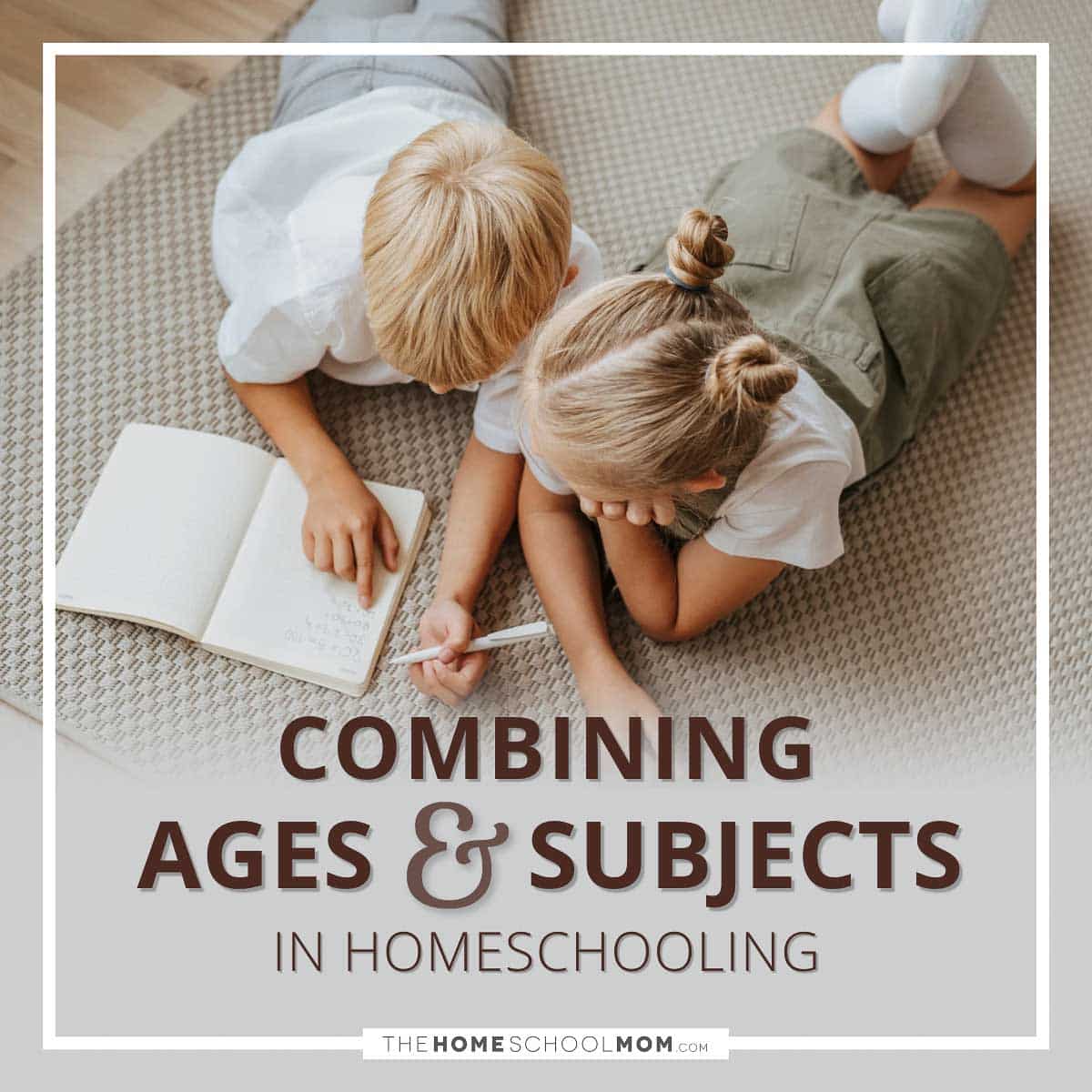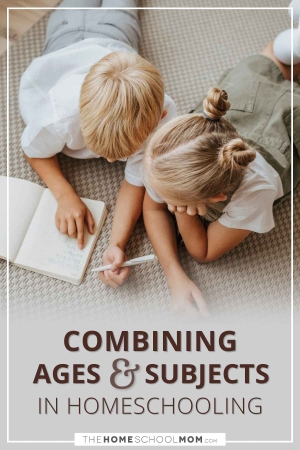Want to get more subjects done with more than one-kid-at-a-time while creating more learning opportunities? Go multi-age and multi-discipinary—homeschooling multiple ages and multiple subjects together.
Look for opportunities to combine different subjects and meet the needs of your different kids at the same time!

How to combine subjects
Combining subjects is called multi-disciplinary learning, or you may have heard it called "interdisciplinary" or "cross-disciplinary." Homeschoolers will often discover the kids are learning in one subject when the parents are aiming at learning in another subject.
For example, a child who is learning about wildlife may develop reading skills as they peruse books about snakes and turtles. That's language arts + science.
A child who is sketching birds on their nature walks is doing art + science.
You can begin to combine subjects on purpose. There may be times you find opportunities to combine keyboarding skills with language arts, coding skills with robotics, art with social studies, music with history or literature, and more.
Example: Put science and social studies together
Here is a little-recognized homeschool miracle: kids can learn social studies through science—and kids can learn science through social studies!
How does this miracle happen?
One way could be by learning about inventors and inventions—the perfect topic for experimenting with multi-discipline, multi-age learning.
Check out the top-notch links we've gathered on inventors and inventions. There are ready-made resources to help you teach your kids both history and science through inventions.
Learning about older inventions and their creators gives kids and teens insight about what life was like before electricity, phones, airplanes, and satellites—providing a chance to imagine "the old days" and how life has changed over time.
That's social studies!
After all, these inventions affect everything from how wars have been fought to how people navigate on trips to how we communicate with people in the next town or state.
At the same time, a growing understanding of technological, engineering, and medical advances (to name a few) can introduce young learners to the workings of computer chips, suspension bridges, and life-saving drugs and surgical techniques.
That's science!
Cutting-edge inventions are often lodged firmly in current events— another aspect of social studies education.
Kids may also enjoy tinkering and trying to create their own inventions. Considering how they themselves might create something useful draws kids into their own personal immersion experience with the scientific method.
That's waaaaaay more exciting and memorable than simply listing the steps of the scientific method on a poster.
How to combine ages
Lots of us have a school-ish picture in our mind of each of our children being in a separate grade and needing to be taught an individual lesson at a specific grade level.
That can be a lot of lessons to prepare and present if you're using a separate grade level curriculum for each child.
With homeschooling, you can meet the needs of more than one child through your choice of resources and through your flexible expectations.
For example, many homeschoolers already enjoy family read-aloud times. You can choose books on your topic that both a 7-year-old and a 10-year-old will like and learn from. Historical fiction is often a great place to start if you are combining history and science. Each child will naturally retain information from the books according to their own ability.
Each child can do activities to reflect or reinforce comprehension (there's another subject!) and help them remember the science and history content. You can adjust your expectations depending on the age and capability of the children. Your younger child might draw a picture of a favorite scene from a book with one or two words written alongside the drawing. Your older child might write a paragraph, answer written questions, or create a game that helps everyone memorize facts about the topic.
Some activities might work for multiple ages in exact the same way—like all the kids, no matter their age, can experience an evening without using electric lights or appliances to consider what life was like before Edison's inventions. Kids will each have their own vocabulary and ability to express what "no electricity" feels like—and they will naturally do so at their own level.
With a larger family, depending on the topic, you may have groupings of more than two kids—maybe you will work with the three oldest together or the three youngest together. It's still fewer lessons to prepare than if you tried to use individual grade level curriculum for each child!
Inspiration for combining ages and subjects
You can combine subjects and siblings when you use a curriculum by picking part of one child's curriculum to present to all the children. You can adjust a lesson or topic "up" or "down" with specific resources and assignments. This happened naturally in my house (which is how I learned to do it), when a younger child began listening in to my older child's lessons on ancient civilizations, especially Egypt.
Once you get used to the idea, you may even be able to moderate your curriculum purchases by choosing one grade level that is aimed at an age or grade level between some of your kids' ages, at least for certain subjects.
And if you like the multi-discipline/multi-child idea, you can take further inspiration by learning how people homeschool with:
- Unit studies
- Interest-led learning
- Project-based homeschooling (affiliate)
- Rabbit trailing
- Unschooling
- Tidal homeschooling
All of these approaches to homeschooling have characteristics easing the way for learning skills or knowledge across multiple subjects. They also make it easier to "spread" learning across multiple ages in your home.
Benefits of combining ages and subjects
Multi-disciplinary, multi-age learning has benefits for children and parents:
- Kids make connections across disciplines, so they cement and synthesize knowledge.
- Siblings learn from each other.
- Kids learn at their unique level of readiness.
- Kids don't need to be considered "behind" or "ahead" to learn.
- Parents cover two or more subjects—or multiple kids—with one preparation. Saves time, energy, and maybe even curriculum money!
- Parents learn to develop cross-curricular thinking and learning—unit studies!
- Parents can enjoy the interesting rabbit trails of knowledge, too.
- Parents may be more able to detect a child or teen's special interest.
- Children's and teens' learning preferences may be revealed.
- Loves hands-on projects or not?
- Prefers documentaries or reading?
- Likes audiobooks or read alouds better?
- Prefers STEAM to STEM—by adding Art into Science, Technology, Engineering and Math?
Schools often find challenges in using these approaches to learning in an era of subject-specific and grade-specific testing. That said, these are time-honored educational methods that often increase the effectiveness of a lesson while managing the amount of prep time for the educator.
Win for the learners; win for the parents!




 A popular speaker at homeschooling conferences, business groups, and parents’ groups, Jeanne Potts Faulconer homeschooled her three sons in North Carolina, Mississippi, and Virginia for twenty years. Holding her Master of Arts degree in Communication, Jeanne conducted portfolio evaluations for Virginia homeschoolers for evidence of progress for many years. Jeanne is a former college faculty member, former editor for several publications, news correspondent for WCVE, and former director of Brave Learner Home. She is the contributing editor for TheHomeSchoolMom newsletter and writes the popular Ask Jeanne column addressing homeschool parents' questions here at TheHomeSchoolMom.
A popular speaker at homeschooling conferences, business groups, and parents’ groups, Jeanne Potts Faulconer homeschooled her three sons in North Carolina, Mississippi, and Virginia for twenty years. Holding her Master of Arts degree in Communication, Jeanne conducted portfolio evaluations for Virginia homeschoolers for evidence of progress for many years. Jeanne is a former college faculty member, former editor for several publications, news correspondent for WCVE, and former director of Brave Learner Home. She is the contributing editor for TheHomeSchoolMom newsletter and writes the popular Ask Jeanne column addressing homeschool parents' questions here at TheHomeSchoolMom.
Leave a Reply